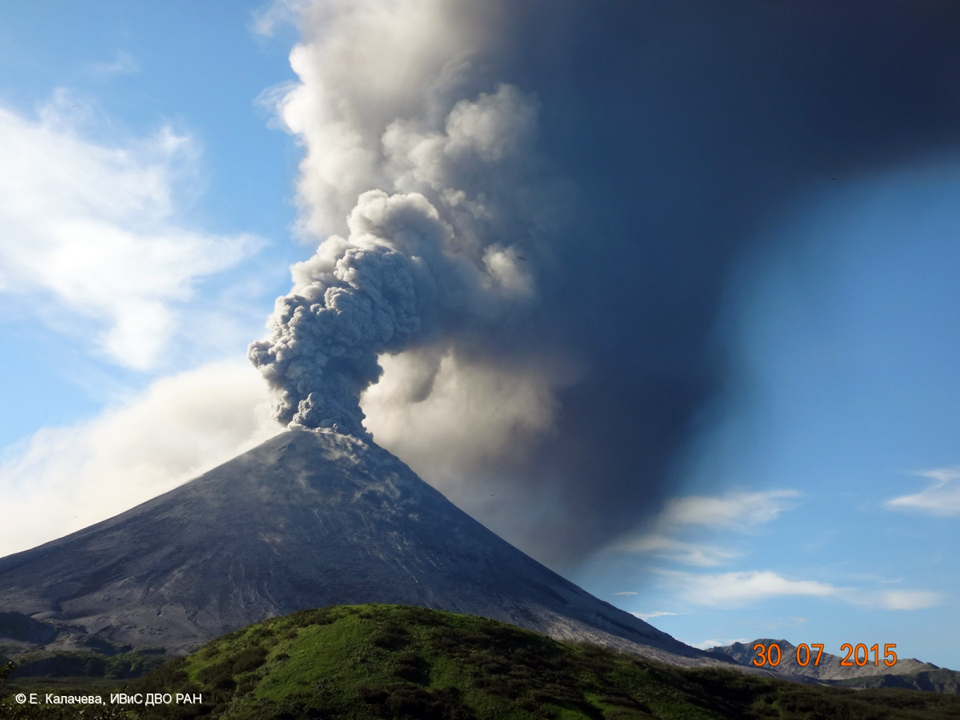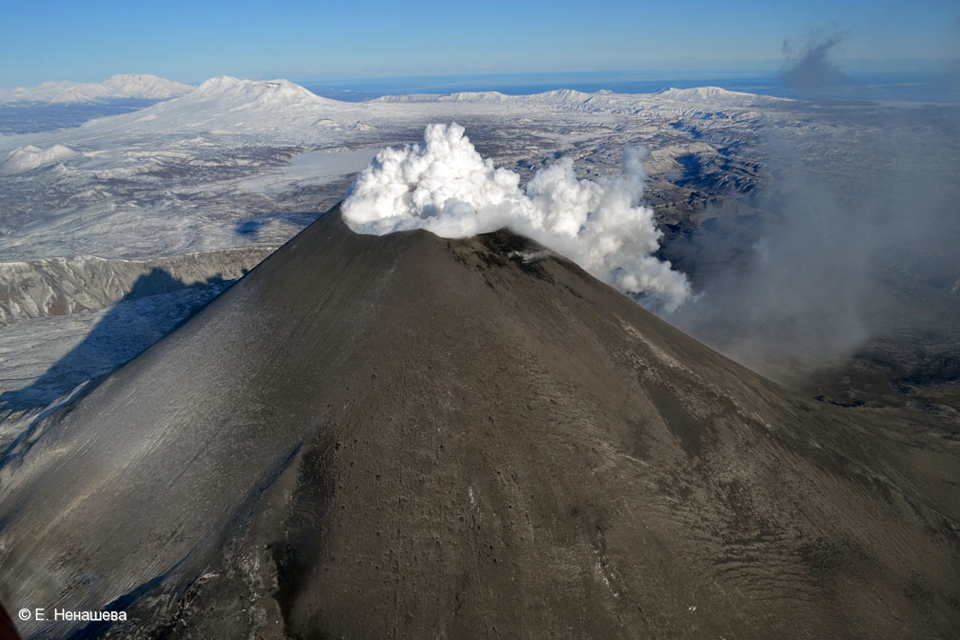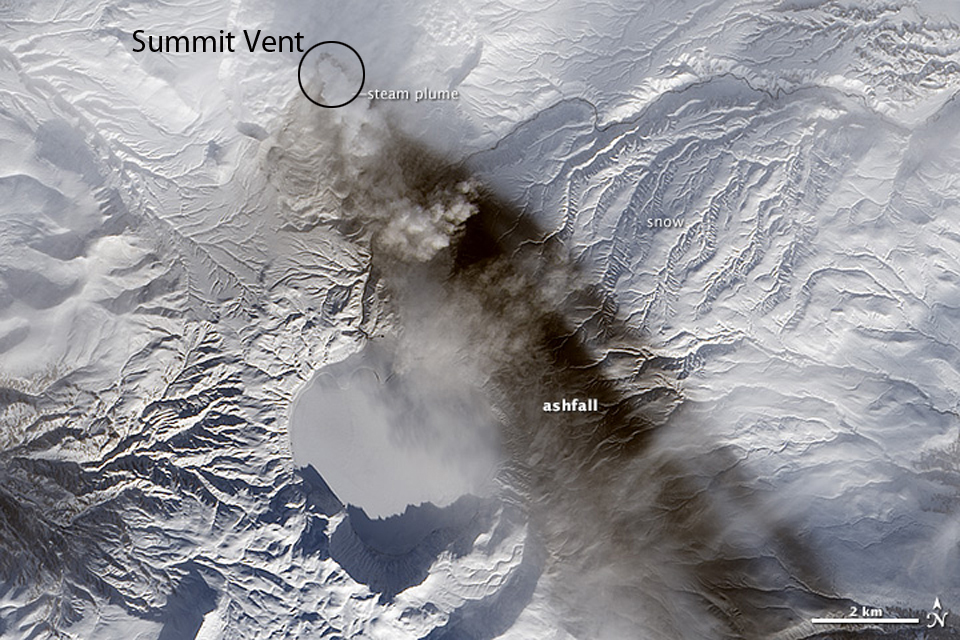Report on Karymsky (Russia) — August 2017
Bulletin of the Global Volcanism Network, vol. 42, no. 8 (August 2017)
Managing Editor: Edward Venzke.
Edited by A. Elizabeth Crafford.
Karymsky (Russia) Persistent ash plumes and thermal anomalies January 2015-March 2016; short-lived explosions with ash, 5-8 October 2016
Please cite this report as:
Global Volcanism Program, 2017. Report on Karymsky (Russia) (Crafford, A.E., and Venzke, E., eds.). Bulletin of the Global Volcanism Network, 42:8. Smithsonian Institution. https://doi.org/10.5479/si.GVP.BGVN201708-300130
Karymsky
Russia
54.049°N, 159.443°E; summit elev. 1513 m
All times are local (unless otherwise noted)
Karymsky volcano on Russia's Kamchatka Peninsula has a lengthy eruptive history based on both radiocarbon data (back to about 6600 BCE) and historical observations (back to 1771). Much of the volcanic cone is surrounded by lava flows less than 200 years old. The most recent activity, consisting of frequent ash explosions and a few lava flows deposited on the flanks, has been ongoing for several decades. The most recent previous report described numerous ash explosions, persistent thermal anomalies, and moderate seismic activity through 2014 (BGVN 40:09). This report covers similar activity from January 2015 through May 2017. Information was compiled from the Kamchatka Volcanic Eruptions Response Team (KVERT), the Tokyo Volcanic Ash Advisory Center (VAAC), and several sources of satellite data.
Ash-bearing explosions and thermal anomalies characterized activity throughout 2015, beginning with an explosion on 19 January. Ash plumes were common through early March 2016, after which only steam-and-gas emissions and occasional thermal anomalies were noted, although fresh ash deposits were observed near the volcano in the second half of March. A brief episode of explosive activity during 5-8 October 2016 produced low-level ash plumes that drifted for hundreds of kilometers. No additional activity was reported through May 2017.
Activity during 2015. An explosive event at Karymsky on 19 January 2015 signaled a return to activity after a few months of quiet. The ash plume from the explosion extended 50 km SE, and the NASA Earth Observatory captured a satellite image showing trace ash deposits from the event trending SE across the snow-covered landscape (figure 34). Ashfall deposits were seen on 1 March (10-15 km E and SE) and 7 March.
Throughout the year, KVERT reported multiple thermal anomalies and ash plumes each month (table 8). The Tokyo VAAC issued 192 aviation alerts during the year, and the MODVOLC system reported eight thermal alerts in January, one in July, and two in August. Ash plume altitudes ranged from 2.1 to 7 km. Continuous ash emissions were noted during 16 and 29-30 July. The ash plume observed in satellite data on 17 July was 8 km long and 5 km wide. Volcanologists observed multiple explosions during 21-22 July, and helicopter pilots in the area reported explosions on 28 July that then lasted for several days (figure 35). Large plumes were also noted during December; on 22 December one was 8 km long and 6 km wide, and on 25 December one was 56 km long and 6 km wide. The highest altitude plumes were reported at 7 km drifting N on 16 and 20 November 2015 by the Tokyo VAAC. Ash plumes drifted in various directions, and were observed as far as 250 km before dissipating.
Table 8. Summary by month of ash plumes and thermal anomalies reported for Karymsky during 2015. Details include dates of thermal anomalies and ash plumes, maximum plume altitude in kilometers, distance in kilometers of ash plume drift, and direction of drift. Multiple thermal anomalies on a given date are shown in parentheses- 23(4)-after the date. 'Date: 7/8' means time zone boundaries presented different reported days for Kamchatka time (KST) and Universal Time (UTC). Sources are KVERT and Tokyo VAAC for ash plume data; KVERT and MODVOLC for thermal data.
| Month | Thermal Anomalies (KVERT) | Thermal Anomalies (MODVOLC) | Ash Plumes | Plume Altitude (km) | Plume Distance (km) | Plume Directions |
| Jan 2015 | 11, 18-31 | 19, 22(2), 23(4), 26 | 19-23, 27, 31 | 2.5-5 | 65-160 | ESE, E, N |
| Feb 2015 | 6, 21, 24 | -- | 23, 27 | 2.7 | 254, 215 | ENE |
| Mar 2015 | 7, 24-26, 29 | -- | 22, 24-26, 27, 29-30 | 2.1 | 154, 150 | E, NE, SW |
| Apr 2015 | 9, 16-17, 23 | -- | 3, 23, 27 | 2.7-3.0 | 85, 35, 140 | SE, SE, NE |
| May 2015 | 4-6, 15-16, 30 | -- | 16/17, 23 | -- | 27, 45 | W, SE |
| Jun 2015 | 6, 8-10 | -- | 8-10 | 4.3 | 50 | SE, E |
| Jul 2015 | 6, 13-14, 16, 17, 25, 27-30 | 13 | 1, 9, 13, 17, 21-22, 25, 27-30 | 2-5.1 | 50-115 | SW, S, E, NW, SE |
| Aug 2015 | 2, 6, 15, 18-21, 24-25 | 19, 24 | 2, 6, 8, 9, 12, 15, 16, 18, 21, 24, 25 | 4.3-5.8 | 25-54 | N, W, SW, SE |
| Sep 2015 | 2, 10, 14-18, 24 | -- | 8, 10, 20 | 4.3-4.6 | 10 | SE, NE |
| Oct 2015 | 4, 8, 11, 20, 22-24, 28 | -- | 3-5, 8, 17-20, 22 | 2.1-4.6 | 50, 100 | SE, E |
| Nov 2015 | 20, 27 | -- | 1/2, 4, 7/8, 10-12, 15-18, 20-21, 30 | 2.5-7.0 | 40-160 | NE, SE, E, ESE |
| Dec 2015 | 3, 6-7, 14, 23-25, 27-28, 31 | -- | 11, 19, 22, 25, 28 | 3.7-5.5 | 145 | E, NE, NW, W, ENE |
 |
Figure 35. Ash plume from an explosion at Karymsky on 30 July 2015. Photo by E. Kalacheva, IVS FEB RAS, courtesy of KVERT. |
Activity during January 2016-April 2017. Activity was variable at Karymsky during 2016 (table 9). The Tokyo VAAC issued 132 aviation notices. Ash plumes and thermal anomalies were most frequent during January and February, with over twenty instances of each during February. The plume heights during February exceeded 6 km altitude four times, with the highest plume of the year on 20 February at 7.6 km altitude. Near-continuous ash emissions during the last week of February resulted in satellite observations of ash deposits around the volcano at the end of the month and during the first few days of March (figure 36). Activity decreased significantly during March, although KVERT noted fresh ash deposits again during 18-25 March. Except for thermal anomalies noted on 1 and 6 April, only steam-and-gas emissions were reported; KVERT lowered the Aviation Alert Level from Orange to Yellow (on a four-color scale) at the end of the month. From May to July, KVERT reported a thermal anomaly once each month. Steam-and-gas emissions were the only activity reported in August, and on 2 September, they lowered the Alert Level from Yellow to Green.
Table 9. Summary by month of ash plumes and thermal anomalies reported for Karymsky during 2016. Details include dates of thermal anomalies and ash plumes, maximum plume altitude in kilometers, distance in kilometers of ash plume drift, and direction of drift. Sources are KVERT and Tokyo VAAC for ash plume data; KVERT and MODVOLC for thermal data.
| Month | Thermal Anomalies (KVERT) | Thermal Anomalies (MODVOLC) | Ash Plumes | Plume Altitude (km) | Plume Distance (km) | Plume Directions |
| Jan 2016 | 1, 3-4, 6-7, 11-15, 18-19, 21, 23, 26, 31 | -- | 3, 5-7, 9, 10, 12-15, 17, 21, 24, 26-28, 31 | 3.9-7.6 | 160-270 | E, NW, SE |
| Feb 2016 | 1-19, 22, 26-29 | 5 | 1-21, 26 | 3.4-7.6 | 125-270 | E, SE, W |
| Mar 2016 | 1-4 | -- | 1 | 5.2 | -- | NE |
| Apr 2016 | 1, 6 | -- | -- | -- | -- | -- |
| May 2016 | 26 | -- | -- | -- | -- | -- |
| Jun 2016 | 25 | -- | -- | -- | -- | -- |
| Jul 2016 | 4 | -- | -- | -- | -- | -- |
| Aug 2016 | -- | -- | -- | -- | -- | -- |
| Sep 2016 | -- | -- | -- | -- | -- | -- |
| Oct 2016 | 7, 12, 17 | -- | 5-8 | 2.4 | 390 | E, SE |
| Nov 2016 | 3 | -- | -- | -- | -- | -- |
| Dec 2016 | -- | -- | -- | -- | -- | -- |
 |
Figure 36. Steam plume from Karymsky on 21 February 2016, and abundant fresh ashfall around the volcano from recent ash emissions. Photo by E. Nenasheva, courtesy of KVERT. |
After six months of quiet, the Tokyo VAAC reported an ash plume on 5 (UTC)/6 (KST) October at 2.4 km altitude extending SE. Aviation alerts were issued through 8 October 2016. Although residing at a fairly low altitude (2.4 km), the plume observed in satellite imagery during 7-8 October was visible in satellite imagery drifting 390 km E and SE before dissipating. KVERT briefly raised the Alert Level to Yellow and then to Orange on 7 and 8 October, and then back to Yellow on 19 October. Three weak thermal anomalies appeared in October and one in November; KVERT lowered the Alert Level to Green on 25 November. Karymsky remained at Alert Level Green through May 2017 with no further reports issued from KVERT or the Tokyo VAAC.
Geological Summary. Karymsky, the most active volcano of Kamchatka's eastern volcanic zone, is a symmetrical stratovolcano constructed within a 5-km-wide caldera that formed during the early Holocene. The caldera cuts the south side of the Pleistocene Dvor volcano and is located outside the north margin of the large mid-Pleistocene Polovinka caldera, which contains the smaller Akademia Nauk and Odnoboky calderas. Most seismicity preceding Karymsky eruptions originated beneath Akademia Nauk caldera, located immediately south. The caldera enclosing Karymsky formed about 7600-7700 radiocarbon years ago; construction of the stratovolcano began about 2000 years later. The latest eruptive period began about 500 years ago, following a 2300-year quiescence. Much of the cone is mantled by lava flows less than 200 years old. Historical eruptions have been vulcanian or vulcanian-strombolian with moderate explosive activity and occasional lava flows from the summit crater.
Information Contacts: Kamchatka Volcanic Eruptions Response Team (KVERT), Far Eastern Branch, Russian Academy of Sciences, 9 Piip Blvd., Petropavlovsk-Kamchatsky, 683006, Russia (URL: http://www.kscnet.ru/ivs/kvert/); Institute of Volcanology and Seismology, Far Eastern Branch, Russian Academy of Sciences, (IVS FEB RAS), 9 Piip Blvd., Petropavlovsk-Kamchatsky 683006, Russia (URL: http://www.kscnet.ru/ivs/eng/); Tokyo Volcanic Ash Advisory Center (VAAC), 1-3-4 Otemachi, Chiyoda-ku, Tokyo, Japan (URL: http://ds.data.jma.go.jp/svd/vaac/data/); Hawai'i Institute of Geophysics and Planetology (HIGP), MODVOLC Thermal Alerts System, School of Ocean and Earth Science and Technology (SOEST), Univ. of Hawai'i, 2525 Correa Road, Honolulu, HI 96822, USA (URL: http://modis.higp.hawaii.edu/); NASA Earth Observatory, EOS Project Science Office, NASA Goddard Space Flight Center, Goddard, Maryland, USA (URL: http://earthobservatory.nasa.gov/).


